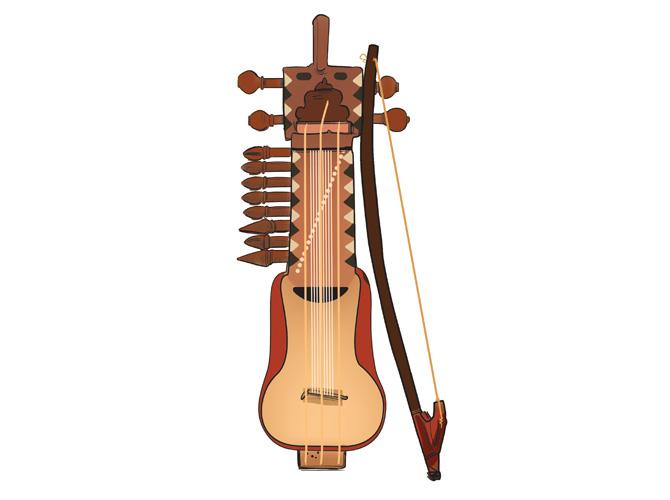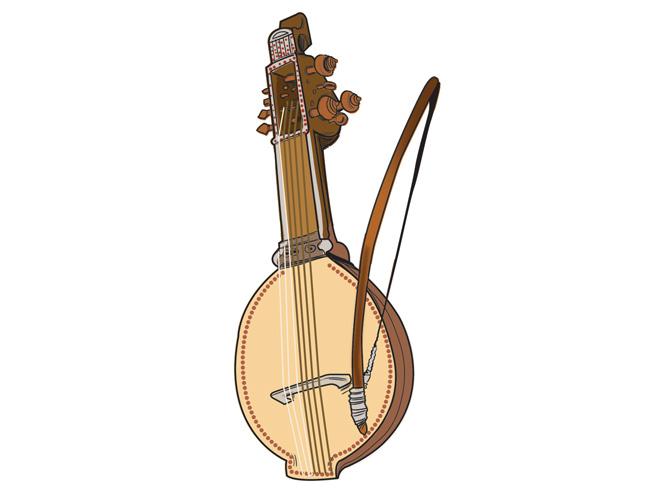What forms the basis for string instruments in India? What was a khartal originally made of? Mame Khan answers these questions, as he turns storyteller ahead of a gig

Kaushiki Chakraborty and Mame Khan perform at a concert in Mumbai
Legend has it that one day, centuries ago, a group of musicians was walking down a forest somewhere in India. While on their journey, they suddenly heard a sound that went something like "trang". It was strangely melodious, and played out at short, irregular intervals. Intrigued, the musicians decided to follow the sound to locate its source, curious to find out what the instrument was.
And much to their astonishment, they realised that it was not an instrument at all. Instead, it was the intestine of an animal, which had toughened up after drying under the sun and was caught between two branches, with the "trang" sound being produced every time a gust of wind unsettled the long, stringy animal part. This led the wonderstruck group to eventually innovate with that concept to replicate the melody. And that's how the ektara — which forms the basis of all Indian string instruments — was born.
ADVERTISEMENT
"I am absolutely sure that this story is 99 per cent — no, make that 100 per cent — true," Mame Khan assures us, after recounting the tale he'd heard while growing up among the Manganiyars, a community of musicians native to Rajasthan. Khan is gearing up to play a gig with Indian classical singer Kaushiki Chakraborty, where the duo will showcase the symbiosis between the semi-classical and folk traditions of music. It will feature a number of instruments that go beyond the usual spectrum of harmoniums, tablas and sitars. And some of these are in fact so rare that you wouldn't find them outside of marginal communities such as the Manganiyars and Bauls of Bengal.
Take the khartal. Although it's an instrument that, today, is made with wood and metal, its origins lie in two stones being struck together to produce a percussive sound. Khan says, "See, when man was first born, he didn't come into this world with any idea of what music is all about. But then he used stones to create fire, which let him cook food. And eventually, he realised that the stones could also produce a pleasing rhythm if they were polished and flattened a certain way. This gradually helped him build a sense of musicality that evolved over the years. And along the line, people starting improvising with more materials, such as wood and animal skins, to create things like the damru, which is considered to be the progenitor of all Indian drum instruments."
He goes on to give us details about some musical contraptions that are indigenous to Manganiyars, and which he will play at the upcoming concert. Here's a brief synopsis of what Khan told us.

Sindhi sarangi
"This is a typical folk instrument, which is different from a classical sarangi. Its make, sound and playing technique are in fact all different. The strings are made of iron, while those of a classical sarangi are made of joda [goat intestines]," Khan says about an instrument that was originally built to accompany vocalists, since its sound can imitate, almost precisely, the different gradations of the human voice.

Kamaicha
"This is considered to be the signature instrument of Manganiyars, and is made of wood from a mango tree. It has 17 strings — 14 of which are made of iron and three from the guts of a goat — and produces a sound as deep as that of a violin. The bow is made of horsehair, and you won't find it being played anywhere outside of our community," Khan shares.

Algoja
The algoja is a double flute made of wood that's different from a single flute, which we call "basuri". "You blow on it with your mouth to produce a 'saa' sound from one of the flutes, and the melody from the other," he says, adding that an algoja comes into play for devotional songs, dedicated to folk deities such as Devnarayan.
ON: June 8, 6.30 pm
AT: Tata Theatre, NCPA, Nariman Point.
CALL: 66223737
ENTRY: Rs 400 to Rs 800
Catch up on all the latest Mumbai news, crime news, current affairs, and also a complete guide on Mumbai from food to things to do and events across the city here. Also download the new mid-day Android and iOS apps to get latest updates
 Subscribe today by clicking the link and stay updated with the latest news!" Click here!
Subscribe today by clicking the link and stay updated with the latest news!" Click here!







